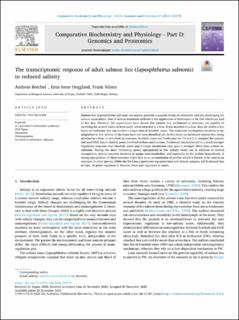| dc.contributor.author | Borchel, Andreas | |
| dc.contributor.author | Heggland, Erna Irene | |
| dc.contributor.author | Nilsen, Frank | |
| dc.date.accessioned | 2021-05-03T14:16:09Z | |
| dc.date.available | 2021-05-03T14:16:09Z | |
| dc.date.created | 2020-12-01T10:23:59Z | |
| dc.date.issued | 2021 | |
| dc.identifier.issn | 1744-117X | |
| dc.identifier.uri | https://hdl.handle.net/11250/2753343 | |
| dc.description.abstract | Salmon lice (Lepeophtheirus salmonis) are marine parasitic copepods living on salmonids and are challenging for salmon aquaculture. One of several treatment methods is the application of freshwater to the fish which can lead to lice loss. However, lab experiments have shown that salmon lice, acclimated to seawater, are capable of surviving for several weeks in freshwater, when attached to a host. If not attached to a host, they die within a few hours in freshwater but can survive a longer time in brackish water. The molecular mechanisms involved in the adaptation to low salinity of the louse have not been identified yet. In this study we incubated salmon lice, being attached to a host, or detached, in seawater, brackish water and freshwater for 4 h and 1 d, sampled the animals and used RNA-Seq to identify genes involved in these mechanisms. Freshwater incubation led to a much stronger regulatory response than brackish water and a longer incubation time gave a stronger effect than a short incubation. Among the most interesting genes, upregulated in low salinity water are in addition to several transporters, several enzymes involved in amino acid metabolism and especially in the proline biosynthesis. A strong upregulation of these enzymes might lead to an accumulation of proline which is known to be used as an osmolyte in other species. While the RNA-Seq experiment was performed with female samples, qPCR showed that at least 10 genes regulated in females, were also regulated in males. | en_US |
| dc.language.iso | eng | en_US |
| dc.publisher | Elsevier | en_US |
| dc.rights | Navngivelse 4.0 Internasjonal | * |
| dc.rights.uri | http://creativecommons.org/licenses/by/4.0/deed.no | * |
| dc.title | The transcriptomic response of adult salmon lice (Lepeophtheirus salmonis) to reduced salinity | en_US |
| dc.type | Journal article | en_US |
| dc.type | Peer reviewed | en_US |
| dc.description.version | publishedVersion | en_US |
| dc.rights.holder | Copyright 2020 The Authors | en_US |
| dc.source.articlenumber | 100778 | en_US |
| cristin.ispublished | true | |
| cristin.fulltext | original | |
| cristin.qualitycode | 1 | |
| dc.identifier.doi | 10.1016/j.cbd.2020.100778 | |
| dc.identifier.cristin | 1854687 | |
| dc.source.journal | Comparative Biochemistry and Physiology - Part D:Genomics and Proteomics | en_US |
| dc.source.40 | 37 | |
| dc.identifier.citation | Comparative Biochemistry and Physiology - Part D:Genomics and Proteomics. 2021, 37: 100778 | en_US |
| dc.source.volume | 37 | en_US |

